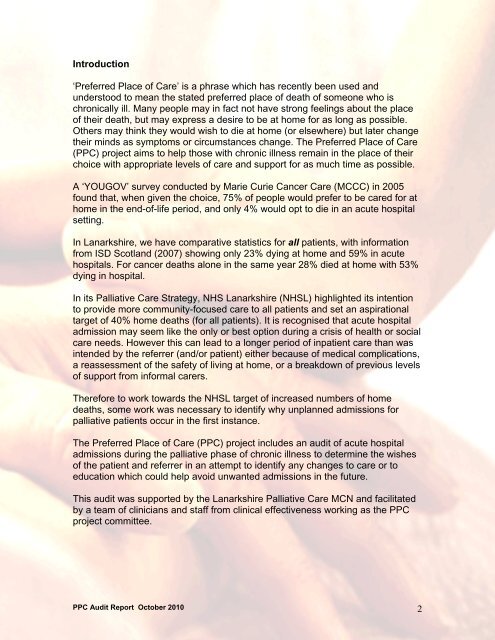Preferred Place of Care Palliative Care Audit ... - NHS Lanarkshire
Preferred Place of Care Palliative Care Audit ... - NHS Lanarkshire
Preferred Place of Care Palliative Care Audit ... - NHS Lanarkshire
Create successful ePaper yourself
Turn your PDF publications into a flip-book with our unique Google optimized e-Paper software.
Introduction<br />
‘<strong>Preferred</strong> <strong>Place</strong> <strong>of</strong> <strong>Care</strong>’ is a phrase which has recently been used and<br />
understood to mean the stated preferred place <strong>of</strong> death <strong>of</strong> someone who is<br />
chronically ill. Many people may in fact not have strong feelings about the place<br />
<strong>of</strong> their death, but may express a desire to be at home for as long as possible.<br />
Others may think they would wish to die at home (or elsewhere) but later change<br />
their minds as symptoms or circumstances change. The <strong>Preferred</strong> <strong>Place</strong> <strong>of</strong> <strong>Care</strong><br />
(PPC) project aims to help those with chronic illness remain in the place <strong>of</strong> their<br />
choice with appropriate levels <strong>of</strong> care and support for as much time as possible.<br />
A ‘YOUGOV’ survey conducted by Marie Curie Cancer <strong>Care</strong> (MCCC) in 2005<br />
found that, when given the choice, 75% <strong>of</strong> people would prefer to be cared for at<br />
home in the end-<strong>of</strong>-life period, and only 4% would opt to die in an acute hospital<br />
setting.<br />
In <strong>Lanarkshire</strong>, we have comparative statistics for all patients, with information<br />
from ISD Scotland (2007) showing only 23% dying at home and 59% in acute<br />
hospitals. For cancer deaths alone in the same year 28% died at home with 53%<br />
dying in hospital.<br />
In its <strong>Palliative</strong> <strong>Care</strong> Strategy, <strong>NHS</strong> <strong>Lanarkshire</strong> (<strong>NHS</strong>L) highlighted its intention<br />
to provide more community-focused care to all patients and set an aspirational<br />
target <strong>of</strong> 40% home deaths (for all patients). It is recognised that acute hospital<br />
admission may seem like the only or best option during a crisis <strong>of</strong> health or social<br />
care needs. However this can lead to a longer period <strong>of</strong> inpatient care than was<br />
intended by the referrer (and/or patient) either because <strong>of</strong> medical complications,<br />
a reassessment <strong>of</strong> the safety <strong>of</strong> living at home, or a breakdown <strong>of</strong> previous levels<br />
<strong>of</strong> support from informal carers.<br />
Therefore to work towards the <strong>NHS</strong>L target <strong>of</strong> increased numbers <strong>of</strong> home<br />
deaths, some work was necessary to identify why unplanned admissions for<br />
palliative patients occur in the first instance.<br />
The <strong>Preferred</strong> <strong>Place</strong> <strong>of</strong> <strong>Care</strong> (PPC) project includes an audit <strong>of</strong> acute hospital<br />
admissions during the palliative phase <strong>of</strong> chronic illness to determine the wishes<br />
<strong>of</strong> the patient and referrer in an attempt to identify any changes to care or to<br />
education which could help avoid unwanted admissions in the future.<br />
This audit was supported by the <strong>Lanarkshire</strong> <strong>Palliative</strong> <strong>Care</strong> MCN and facilitated<br />
by a team <strong>of</strong> clinicians and staff from clinical effectiveness working as the PPC<br />
project committee.<br />
PPC <strong>Audit</strong> Report October 2010 2

















